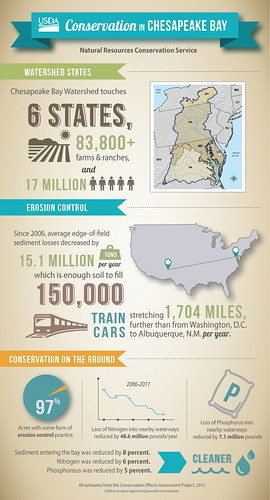
Yesterday, Agriculture Secretary Tom Vilsack visited a Virginia Century Farm in Stafford County to release a new report that shows how farmers like Gerry Silver are helping make significant progress in reducing sediment and nutrient runoff into the Chesapeake Bay Watershed.
The Secretary lauded Silver Ridge Farm as a gold standard for conservation because the owners have implemented voluntary conservation practices such as cover crops and no-till planting to control soil erosion and prevent the release of nitrogen and phosphorus into area waterways. Though the family has kept the land in continuous agricultural use for more than 100 consecutive years, he called the operation a “farm of the future” because the family has continued to evolve their operation over time to maintain productivity and diversify income opportunities.
The farm was the perfect setting to spotlight USDA's Natural Resources Conservation Service (NRCS) Conservation Effects Assessment Project (CEAP) report, the only regional effort that scientifically and statistically matches farmers’ actions with soil, landscape and climate to quantify agricultural impacts on water quality. The report estimates that conservation practices applied by farmers and landowners in the region since 2006 are reducing nitrogen and phosphorus leaving fields by 48.6 million pounds each year (26 percent) and 7.1 million pounds (46 percent) respectively.
In addition, the report said the use of cover crops nearly quadrupled from 2003-2006 to 2011, with adoption increasing from only 12 percent of acres to 52 percent of acres with a cover crop at some point in the rotation. In 2003-2006, 19 percent of cropped acres had a high need for conservation treatment; by 2011, only four percent of acres were in that category.
Importantly, conservation practices adopted by Bay producers since 2003-06 have reduced average annual edge of field losses of sediment by 15.1 million tons (60 percent). This amount of sediment would produce enough dirt to fill 150,000 railroad cars on a train that would stretch 1704 miles, or further than the distance from Washington, DC, to Albuquerque, New Mexico, every year.

Richard Street, At-Large Member of the Virginia Soil and Water Conservation Board, highlighted the need for partnership efforts to improve Bay health. “USDA, NRCS, and state agencies need to work together to assist local jurisdictions and governments to improve the health of the Bay”. Street, who is also a Senior Environmental Engineer with Spotsylvania County, added, “In Spotsylvania County, we took our cue from farmers in using a voluntary approach to conservation activities in urban settings with low impact development.”
The National Association of Conservation Districts (NACD) released a statement saying it was pleased by the CEAP report findings. According to NACD, “The report, which demonstrates a reduction in runoff of nutrients and sediment in the Chesapeake Bay Watershed, reflects the focused approach on implementing voluntary, incentive-based conservation practices in the Bay through the partnership of conservation districts, producers, state and federal agencies including NRCS and the Farm Service Agency.”
"This is a great day for agriculture," said NACD President Earl Garber. "The CEAP report clearly demonstrates that producers' proactive, voluntary use of good conservation practices is paying off in a big way in the watershed."
Sean Garvin, Region 3 Administrator for the Environmental Protection Agency said, "Farmers have stepped up their efforts to implement conservation practices to clean up the Chesapeake Bay Watershed and the progress reported by USDA in its CEAP report today is consistent with the rates reported through the Chesapeake Bay Program (CBP) Partnership.”
The Chesapeake Bay Watershed touches six states (Delaware, Maryland, New York, Pennsylvania, Virginia and West Virginia) and the District of Columbia. The area is home to 17 million people. More than 150 major rivers and streams flow into the Bay, the largest estuary in the United States.
The full report, along with a fact sheet, summary and infographic, is available here. Learn more about USDA's Conservation Effects Assessment Project.

